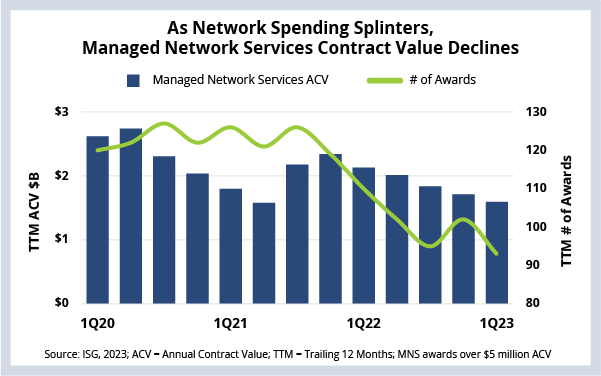If someone forwarded you this briefing, consider subscribing here.
NETWORK
A reliable, secure network is more critical than ever as companies modernize and transform their businesses. However, legacy private networks are shifting to software-defined transformations, and enterprises are increasingly outsourcing network management separately from the data network. This coupled with the rapid rise of cloud-based communication and collaboration services means that the annual contract value of managed network services has been steadily declining.
DATA WATCH

Background
For decades, enterprises have relied on private networks to transport data. These networks were secure, reliable and, usually, very expensive. One of the big reasons they were so expensive is that they were backed by performance guarantees, which ensured the applications that ran on these networks would perform as needed.
That started to change in 2016 when enterprise cloud adoption really started to take off and back-office applications like email and collaboration began moving to the cloud. These applications not only used the cloud vendor’s infrastructure, but they also used the public internet rather than expensive private networks to access them.
Next came software-defined networking, or SDN. SDN separates the network “intelligence” from the network hardware. When it’s deployed over a wide-area network, a company can build a single management layer over multiple networks. This enables enterprises to outsource their network management separately from the data network, which impacts contract values.
The combination of these two megatrends is driving network ACV – and deal counts – lower.
The Details
- Managed network outsourcing ACV declined 39% from 1Q20 to 1Q23.
- Award counts are down 23% over the same time period.
What's Next
It’s important to remember that that network is still the factory floor of any enterprise technology transformation. It’s just that the floor looks very different than it did five years ago.
And one of the biggest changes – and biggest opportunities for service providers – is the chance to build and manage a next-generation network, which is designed around the principle that people, data and applications operate across multiple clouds.
This is a huge and complex change for most enterprises – especially those with aging network management workforces (a big challenge in this area of enterprise IT).
So, look for enterprises to continue to optimize their underlying network transport costs in order to fund these next-generation network modernization initiatives.
Reminder that the 2Q23 Index Call is July 13 at 9:00 AM ET. Steve, Kathy, Namratha and I look forward to taking your questions on the health and growth of the industry.
